Hobart launch: S. Group's Monica Plunkett and Javan Griffiths
Introduction by Kuno Director Vanessa Bleyer:
Now, to obviously use technology to disconnect people from technology and reconnect them with Nature, we need creative design. And Kuno is blessed with the elite skills of S. Group. I'd now like to introduce you to Monica Plunkett and Javan Griffiths, both from S. Group.
Monica studied fine arts at the University of Tasmania before acting as Senior Art Director for Cleminger, which took her design skills across the country, before returning to Tasmania. So she brought her incredible talents into developing the beautiful logo that is Kuno. Javan has a decade of experience in design and development. Along with Josh, Harsha and now Pri, Javan has worked painstakingly with the team at Kuno to lead its technical development.
Please welcome up to the front here to Monica and Javan.
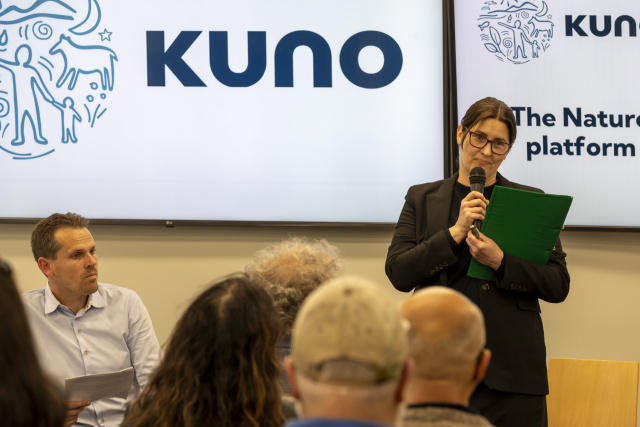
Monica Plunkett: Thank you, nice to see everyone here and thank you Phill for all that background, it was beautiful to hear your story and everything that has come about. As you can imagine at S. Group, we love to take people's ideas and bring them to reality, and someone like Phill and his partners come along with a great big bucket load of ideas and content and huge dreams. It could have been quite overwhelming, but it was our task to try and distill it all into something that worked.
And so the first step for us was strategically taking a look at the brand, and trying to hopefully succeed with coming up with a logo that captures a lot of what people's ideas were.
And that was doing something that balanced that idea of Nature, and that childhood love of Nature and what's important to us, with something that is quite clean and captures that idea of technology. So that's how the brand was formed.
It was very simple in the end, but obviously as with any great idea, it took a long time to get there. And then from that logo we then applied it to a whole lot of brand collateral, but especially the website. So elements from that brand have then come across to the website.
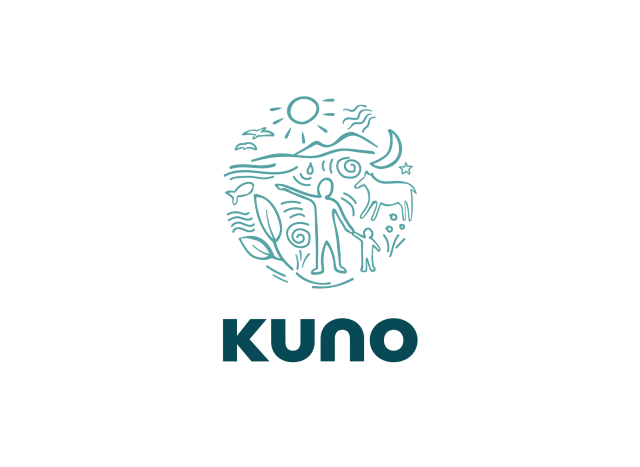
There was a great deal of time that we went into what we call their user experience, and user interface of that website. It's not enough just to have great ideas... we have to be really careful about how people track through the website and make things really user-friendly so that they can find things easily.
And that's where Javan has a great deal of expertise. He didn't just code the website with all the fancy languages, HTML and things, but he also thinks really carefully about how people want to use the website to interact with it. So I think the next step is for Javan to step through some of those key features of the website and explain it.
Javan Griffiths: Phill, that was awesome, very passionate and can see your passion. It's awesome to be involved in a project where we can come together with our passions and build something that I think is really amazing. We've made a really good start to what we want to accomplish. So thank you very much, Phill, for the opportunity to be part of this with you and part of this journey.
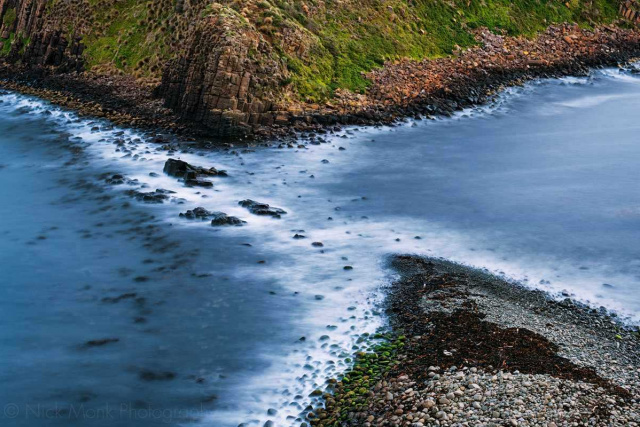
When we're working on any sort of web project it's important for us to understand the different users that are coming to the website, in order to balance the different needs that users might have when they visit - and, build an experience that meets those needs.
There's also the ability to be able to look through the Network section of the site, which allows people to connect with the different groups and people who are working in different initiatives, and filter those by topics. So as users are going through the website and looking at this content, they also have the ability to follow the authors or the groups that have written those or produce that content, and connect with them. They can explore throughout the site.
We've heard a bit about that already, where we have people with very different needs... people coming there initially, perhaps without really much exposure to Nature, who is in that digital age. How do we engage with them and entice them into the website, and provide an experience for them that takes them through and helps them try and find a passion and connect with Nature?
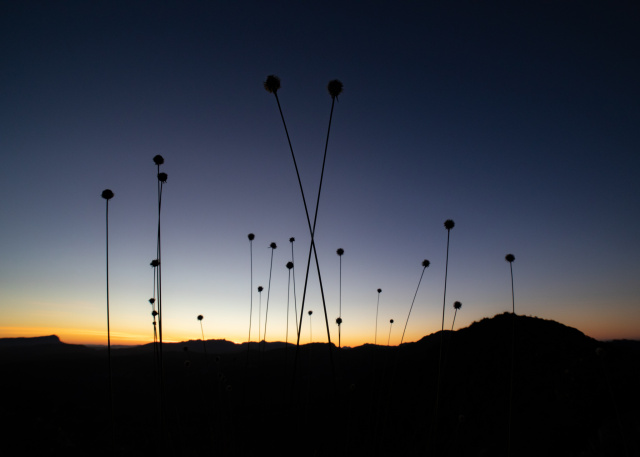
Then, on the other side, we have users that are already involved with Nature and who might be part of a group, or are working on their own and want to try and build their presence online, to try and entice people to be part of their passion and join that process.
That journey, especially for users coming to the site that don't really have a much of a connection with Nature, starts on the homepage with a beautiful map of our world. They are able to jump in and explore the globe and the different regions of content - the field guides for different regions - throughout the Earth. So that experience I think is something that can connect with a range of different people who are able to come in. It's very much a simple yet powerful motif, I think, having the ability to look through the globe and explore a particular place.
So here we have someone being able to go through to a particular region and discover more information about that region. They're able to find beautiful, in-depth information about the Nature and the heritage and everything that goes along with building out the content around a particular region.
Going through the different content of the Bruny Island Field Guide as an example, there are different sections of the field guide community, articles and galleries for people to connect with. And then we have this second layer to field guides as well, which Phill and I spent a lot of time talking through and understanding these different layers, and allowing people to delve deeper into more specific information about a particular region, if they plan to visit that region or if they want to delve into more specific information on walks and elements like that.
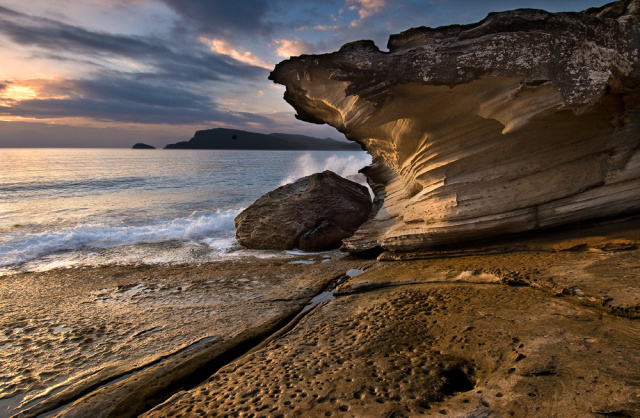
So we connect people right through, from more of a general interest in the early stages through to then more specific information about actually visiting that location later on, if they have the ability to go to that particular area and discover that region in person.
We're tapping into the idea of a traditional field guide, where you have those first few pages that are providing information about the content, and then leading users through to more specific information about that area because they want to actually go and visit. They might want to meet people who are advocating for that area and find out more about the place they're going to.
The Network tab here is a way that people can highlight the different people who are creating content on the site. You can sign up and become a contributor, and then users can contribute articles of content.
That's a large part of the experience that we have to work through as well... how do we create a simple and easy experience so that we can create what we call user-generated content, to allow people to contribute content to the site and grow the platform organically that way?
It's a big task to try and create all of that content for our planet. We're obviously going to rely on other people to help us with that. Thanks Phill.
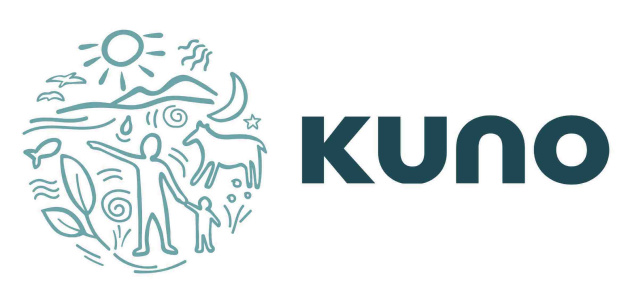
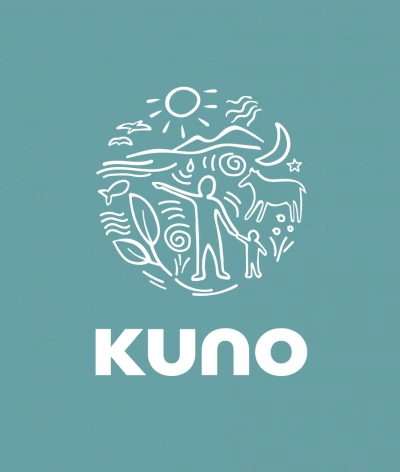
Kuno
Introduction by Kuno Director Vanessa Bleyer:
Now, to obviously use technology to disconnect people from technology and reconnect them with Nature, we need creative design. And Kuno is blessed with the elite skills of S. Group. I'd now like to introduce you to Monica Plunkett and Javan Griffiths, both from S. Group.
Monica studied fine arts at the University of Tasmania before acting as Senior Art Director for Cleminger, which took her design skills across the country, before returning to Tasmania. So she brought her incredible talents into developing the beautiful logo that is Kuno. Javan has a decade of experience in design and development. Along with Josh, Harsha and now Pri, Javan has worked painstakingly with the team at Kuno to lead its technical development.
Please welcome up to the front here to Monica and Javan.

Monica Plunkett: Thank you, nice to see everyone here and thank you Phill for all that background, it was beautiful to hear your story and everything that has come about. As you can imagine at S. Group, we love to take people's ideas and bring them to reality, and someone like Phill and his partners come along with a great big bucket load of ideas and content and huge dreams. It could have been quite overwhelming, but it was our task to try and distill it all into something that worked.
And so the first step for us was strategically taking a look at the brand, and trying to hopefully succeed with coming up with a logo that captures a lot of what people's ideas were.
And that was doing something that balanced that idea of Nature, and that childhood love of Nature and what's important to us, with something that is quite clean and captures that idea of technology. So that's how the brand was formed.
It was very simple in the end, but obviously as with any great idea, it took a long time to get there. And then from that logo we then applied it to a whole lot of brand collateral, but especially the website. So elements from that brand have then come across to the website.

There was a great deal of time that we went into what we call their user experience, and user interface of that website. It's not enough just to have great ideas... we have to be really careful about how people track through the website and make things really user-friendly so that they can find things easily.
And that's where Javan has a great deal of expertise. He didn't just code the website with all the fancy languages, HTML and things, but he also thinks really carefully about how people want to use the website to interact with it. So I think the next step is for Javan to step through some of those key features of the website and explain it.
Javan Griffiths: Phill, that was awesome, very passionate and can see your passion. It's awesome to be involved in a project where we can come together with our passions and build something that I think is really amazing. We've made a really good start to what we want to accomplish. So thank you very much, Phill, for the opportunity to be part of this with you and part of this journey.

When we're working on any sort of web project it's important for us to understand the different users that are coming to the website, in order to balance the different needs that users might have when they visit - and, build an experience that meets those needs.
There's also the ability to be able to look through the Network section of the site, which allows people to connect with the different groups and people who are working in different initiatives, and filter those by topics. So as users are going through the website and looking at this content, they also have the ability to follow the authors or the groups that have written those or produce that content, and connect with them. They can explore throughout the site.
We've heard a bit about that already, where we have people with very different needs... people coming there initially, perhaps without really much exposure to Nature, who is in that digital age. How do we engage with them and entice them into the website, and provide an experience for them that takes them through and helps them try and find a passion and connect with Nature?

Then, on the other side, we have users that are already involved with Nature and who might be part of a group, or are working on their own and want to try and build their presence online, to try and entice people to be part of their passion and join that process.
That journey, especially for users coming to the site that don't really have a much of a connection with Nature, starts on the homepage with a beautiful map of our world. They are able to jump in and explore the globe and the different regions of content - the field guides for different regions - throughout the Earth. So that experience I think is something that can connect with a range of different people who are able to come in. It's very much a simple yet powerful motif, I think, having the ability to look through the globe and explore a particular place.
So here we have someone being able to go through to a particular region and discover more information about that region. They're able to find beautiful, in-depth information about the Nature and the heritage and everything that goes along with building out the content around a particular region.
Going through the different content of the Bruny Island Field Guide as an example, there are different sections of the field guide community, articles and galleries for people to connect with. And then we have this second layer to field guides as well, which Phill and I spent a lot of time talking through and understanding these different layers, and allowing people to delve deeper into more specific information about a particular region, if they plan to visit that region or if they want to delve into more specific information on walks and elements like that.

So we connect people right through, from more of a general interest in the early stages through to then more specific information about actually visiting that location later on, if they have the ability to go to that particular area and discover that region in person.
We're tapping into the idea of a traditional field guide, where you have those first few pages that are providing information about the content, and then leading users through to more specific information about that area because they want to actually go and visit. They might want to meet people who are advocating for that area and find out more about the place they're going to.
The Network tab here is a way that people can highlight the different people who are creating content on the site. You can sign up and become a contributor, and then users can contribute articles of content.
That's a large part of the experience that we have to work through as well... how do we create a simple and easy experience so that we can create what we call user-generated content, to allow people to contribute content to the site and grow the platform organically that way?
It's a big task to try and create all of that content for our planet. We're obviously going to rely on other people to help us with that. Thanks Phill.

You might like...

Hobart launch: Director Dr Phill Pullinger on the power of Kuno's mission

Hobart launch: Director Alec Marr on seeing what's in front of us

Hobart launch: introducing Raz Salvarita

Hobart launch: writer Helen Cushing on how to contribute to Kuno
Newsletter
Sign up to keep in touch with articles, updates, events or news from Kuno, your platform for nature
